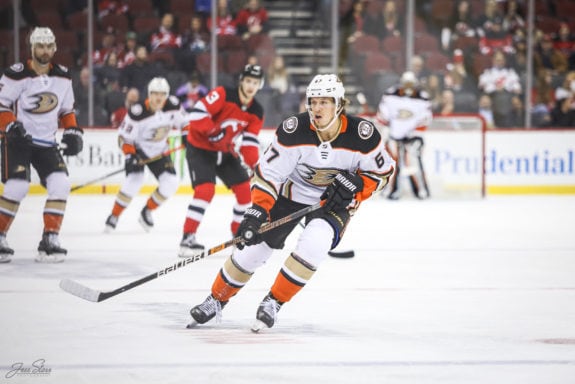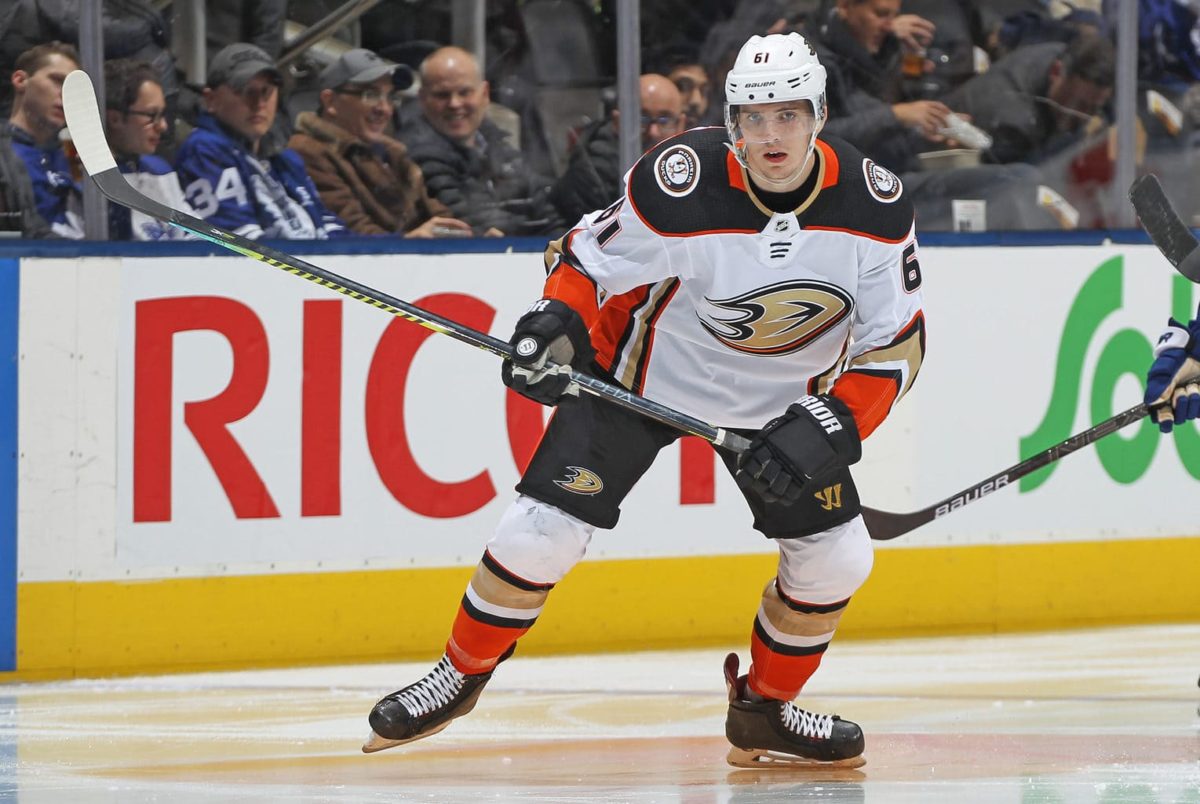With the Anaheim Ducks’ 2020-21 season finally in the books, it’s time to look back on their forward group and hand out some performance reviews. In this edition, we’ll look specifically at the Ducks’ forward group with a focus on their defense corp and goaltenders coming shortly after. We have set a 10-game minimum to be on the list, so that excludes Sonny Milano, Vinni Lettieri, Andrew Agozzino & Chase De Leo.
In terms of how they were graded, I looked at the scoresheet and season statistics, but I also focused on how much they exceeded expectations this season based on their past performances for the team. I also considered whether these players helped the team in the area they were brought in to boost if they were able to show potential of their own and if they added to the team’s potential going forward. An A means they likely exceeded expectations and were among the most impressive Ducks’ forwards all season, B means they met expectations across the board and showed improvements in a few key areas of their development, a C means they simply met expectations and didn’t stand out above the ordinary, and anything below is not good.
Maxime Comtois
2019-20 season: 5 goals, 6 assists for 11 points in 29 games played
2020-21 season: 16 goals, 17 assists for 33 points in 55 games played
Analysis: In a season where everyone was expecting the kids to take a step forward, no one improved as much as Maxime Comtois. The Longueuil, Quebec native, led the Ducks in scoring with 16 goals and 17 assists for 33 points in 55 games played. He also played the most games of any Ducks’ forward, with Rickard Rakell trailing behind him at 52. Not only did his production substantially increase, but he also became a better play driver in the process, with his Corsi-for per 60 relative (CF/60 Rel) improving to 10.47 from -0.63 during the 2019-20 season. He ranked fourth among Ducks’ forwards in expected goals-for percentage (xGF%) with 49.03, which trailed only Trevor Zegras, Rakell and Ryan Getzlaf.
He’s becoming a complete forward for the team, ranking second in shots on goal (94), third in blocks (34), and third in hits (93) among Ducks forwards. The Ducks’ power play was abysmal again this season, and if Comtois can add being a consistent power play contributor to his resume, then he’ll be a safe bet to be among the Ducks’ top scorers for the foreseeable future.
Grade: A-
Rickard Rakell
2019-20 season: 15 goals, 27 assists for 42 points in 65 games played
2020-21 season: 9 goals, 19 assists for 28 points in 52 games played
Analysis: All things considered, Rakell had a fairly productive season with nine goals and 19 assists for 28 points. In a full 82-game season, he would’ve been on pace for 44 points, which is certainly a respectable season for the Swedish winger. The problem is the Ducks are relying on him to be more than just an average middle-six forward. Back-to-back 30-goal seasons from 2016-17 to 2017-18 still plague Rakell when it comes to his expected production for Anaheim.
Despite ranking second in team scoring and leading the team in shots on goal, it’s still a disappointing season from the 27-year-old. His 14-goal and 44-point pace are his lowest marks since the 2014-15 season, which was his first full season in the NHL. He also recorded his lowest goals per 60 (G/60) and points per 60 (P/60) totals of his entire career, coming in at .58 and 1.81, respectively.

Rakell was also operating with a career-low shooting percentage of 6.3 percent, which obviously doesn’t account for all his struggles this season, but it’s still something to consider. Whether he was unlucky or not, expectations-wise, it was not a successful season for him. He’s a perfectly capable middle-six winger that most teams would love to have on their roster, especially at his extremely team-friendly salary, but for a team as bad as Anaheim offensively, you just hope for a little bit more. Unfortunately, we didn’t get that from him this season, and if he is still on the team come the start of the 2021-22, it will be a big season for the future unrestricted free agent. I’ve stopped considering him as a 30-goal scorer, so he came in slightly under my expectations this season. A D-rating feels a little harsh, so I settled for a C-minus.
Grade: C-
Nicolas Deslauriers
2019-20 season: 7 goals, 6 assists for 13 points in 59 games played
2020-21 season: 5 goals, 5 assists for 10 points in 49 games played
Analysis: I could easily grade Nic Deslauriers as an F and just move on to the next player on the list, but since we’re grading based on expectations, it’s a little more complex than that. In terms of what you’d expect to get from Deslauriers, he didn’t fail to deliver. He led Ducks forwards in hits with 136 and penalty minutes with 53. He had the third most fighting majors in the NHL with five, trailing only Zac MacEwen (6), Austin Watson (6) and Brady Tkachuk (7). As for his production, he was averaging more minutes (11:19) than he has ever had in his time with Anaheim, and he was on pace to just surpass his career-high in points. All things considered, he did what he was asked to do without going above and beyond his capabilities. Therefore, a C-rating seems more just appropriate than labeling him with an F.
Grade: C
Troy Terry
2019-20 season: 4 goals, 11 assists for 15 points in 47 games played
2020-21 season: 7 goals, 13 assists for 20 points in 48 games played
Analysis: A tale of two seasons from the Denver native, as he became a completely different player for the Ducks from the month of March onward. After recording just two goals and two assists in his first 17 games of the season, he recorded five goals and 11 assists for 16 points in the final 31 games of the season. A point-per-game difference of (.235) to (.516), which would’ve seen him finish a full 82-game season with approximately 42 points. He was scratched for three straight games heading into March and emerged a more confident and composed player. He also saw an increase in his time on ice, going from averaging 12:53 to 15:41. He ranked fifth on the team in scoring with 20 points and continued to be an effective play driver, ranking second among forwards with a 51.86 CF% and first in expected goals with a 51.24 xGF%.

The real defining point of the season for Terry is the final stretch, where he was paired with Trevor Zegras and Comtois. The trio formed the Ducks’ most dangerous and exciting line of the season, even if it was only for the last seven games of the season. For the start of the season, I’d give him a D-rating, and for the way he played after March, I’d give him a B-plus, so we’ll meet in the middle and end up with a B-minus. If those three can stay together for the majority of the 2020-21 season, it bodes well for where Terry could finish after next season.
Grade: B-
Ryan Getzlaf
2019-20 season: 13 goals, 29 assists for 42 points in 69 games played
2020-21 season: 5 goals, 12 assists for 17 points in 48 games played
Analysis: Despite this season being Ryan Getzlaf’s worst of his career when it comes to point production, it would be unfair to judge him solely on his offensive impact, especially at 35 years of age. The most telling sign of the Ducks’ struggles on the power play is that Getzlaf led the team in power play goals with three. The only other players with more than one were Max Jones and Jakob Silfverberg, who both had two. His dip in production isn’t surprising as he has been slowly declining as the years have gone on. He also only averaged 16:35 time on ice, which was his lowest total since the 2006-07 season. All that said, yes, Getzlaf had a rough season, but it was also to be expected.
While his golden years may be behind him, he can still play a valuable role on this team moving forward. He led all Ducks’ forwards in blocks with 46, won the most faceoffs of anyone on the team with 350, and is a leader in the dressing room for the current crop of Ducks youngsters. It remains to be seen whether he returns to the Ducks next season. The captain sees his $8.25-million contract come to an end and will need to make a decision on his future. If he does play again next year, make no doubts about it, it will be with the Ducks and no one else.
Grade: C
Jakob Silfverberg
2019-20 season: 21 goals, 18 assists for 39 points in 66 games played
2020-21 season: 8 goals, 8 assists for 16 points in 47 games played
Analysis: It almost feels harsh giving Jakob Silfverberg a D-rating now that the news of his hip injury has surfaced, but he’s apparently been playing through this for the last two years, so we’ll stick with the rating. Over the past five seasons, he has recorded at least 20 goals in four of them, only missing the mark during the 2017-18 season, where he had 17 goals in 77 games played. With only eight goals this season, he was on pace for 14 goals, which would be his lowest since he scored 13 during the 2014-15 season.

He continued to do everything else well, scoring one of the Ducks’ two shorthanded goals and ranked second among Ducks’ forwards in time on ice during the penalty kill, trailing only Derek Grant. His shooting percentage took a dip to 8.8 percent this season, which is drastically lower than his last two seasons and well under his career average of 10.1 percent. He also led the Ducks in takeaways with 25. Everything we expect to see from Silfverberg on the defensive side of the game was on display this season. Unfortunately, his offensive production took a major dip, and in a year where the Ducks were desperate for goal scoring, he was a notable absentee.
Grade: D
Derek Grant
2019-20 season: 14 goals, 6 assists for 20 points in 49 games played
2020-21 season: 6 goals, 9 assists for 15 points in 46 games played
Analysis: It’s not a good sign when Derek Grant ranks seventh on your team in scoring, but that was the unfortunate reality for the Ducks this season. Never known for putting the puck in the back of the net, he was still always a guy you could count on for 10-15 goals in a season and to jump up into the lineup due to injuries. It’s not like he didn’t do that this year, but in a season where he averaged more time on ice than he’s ever had in his career, at 14:34, he failed to take advantage of his opportunities. He was on pace for just ten goals this season as well as ranking second-last in both CF% and xGF% with 41.74% and 37.83%, respectively.
He’s never been a play driver, but his 14 goals at least covered up some of the warts last season. Without that this season, it seems like the #Elite1C meme has died out and fans are getting fed up at the negative impact he has on a nightly basis. He has two more years left with an average annual value of $1.5 million, so Ducks fans will have to get used to feeling this way about Grant unless he ends up getting traded.
Grade: D-
Max Jones
2019-20 season: 8 goals, 4 assists for 12 points in 59 games played
2020-21 season: 7 goals, 4 assists for 11 points in 46 games played
Analysis: It wasn’t quite a Comtois-like jump for Max Jones this season, but he still managed to continue to improve on other aspects of his game. His numbers were almost identical to last season in 13 fewer games, and he managed to chip in two power play goals in the process. What’s more impressive about all of this is the Ducks’ usage of Jones shifted dramatically this season, and he was deployed heavily in the defensive zone compared to seasons prior. Only 48.48 percent of his zone starts were in the offensive zone this season compared to 64.94 percent last year and 62.62 percent during the 2018-19 season.

He ranked second among Ducks’ forwards in hits with 100, going from averaging 1.4 hits per game last season to 2.2 hits per game this year. His responsibility with the puck on his stick improved, going from 32 giveaways last season to only 10 this year. He also led the Ducks in penalties drawn with 19, and only Troy Terry came close to matching that with 13. A slightly larger increase in his offensive production would’ve seen him net a B-rating, but we’ll have to settle for a B-minus for now. A quietly impressive season from the former first-round pick.
Grade: B-
Adam Henrique
2019-20 season: 26 goals, 17 assists for 43 points in 71 games played
2020-21 season: 12 goals, 9 assists for 21 points in 45 games played
Analysis: From the Ducks’ top scorer in 2019-20 to being waived to captaining Team Canada to a 2-0 loss against Latvia at the World Championships, it certainly has been an interesting year for Adam Henrique. He ranked second on the Ducks in goal scoring and was the only other Ducks’ forward to record more than ten goals along with Comtois. His 82-game point pace of 38 points would’ve set him up for his worst season production-wise since 2012-13. It’s a common thread for several Ducks’ forwards this season and indicative of the team performance as a whole.
He was one of the team leaders among forwards in both CF% and xGF% last season and fell to eighth in both categories in 2020-21. He continued to have a positive impact in the faceoff dot, winning 55.4 percent of his draws, slightly higher than the 55 percent he clicked at last season. He falls in the same boat as Rakell in that he was expected to produce more offensively for the team this season and failed to hit those targets.
Grade: D
Danton Heinen
2019-20 season: 3 goals, 1 assist for 4 points in 9 games played
2020-21 season: 7 goals, 7 assists for 14 points in 43 games played
Analysis: It wasn’t the breakout season we all hoped for in Danton Heinen’s first full season with the Ducks. His seven goals were tied with Jones and Terry for fifth on the team, and he ranked eighth in team scoring among forwards. In Anaheim, he’s been deployed as a more defensive forward rather than the offensive role he was given with the Boston Bruins. He started just 49.73 percent of his 5-on-5 zone starts in the offensive zone this season, a far cry from the 62.03 percent he had in his last season with Boston. A lot of that has to do with the gap in quality between the two teams and the fact that the Ducks just don’t get as many offensive zone faceoffs as the Bruins do. However, he has also been a mainstay on the penalty kill this year, something he rarely did in Boston.
Latest Ducks Content:
- Anaheim Ducks 2024-25 Projected Lineup
- Ducks’ 2024-25 Bounce Back Candidates: Trevor Zegras
- Red Wings Should Still Pursue John Gibson Trade
- Anaheim Ducks Logo History
- Ducks News & Rumors: LaCombe, Vatrano, Sennecke & More
He’s a great complementary piece to a playoff-bound team, but with Anaheim, he struggled to find consistency and bounced between several different line combinations. Considering the role he was given this season, he didn’t really fall that short of expectations. With some more offensive weapons spread throughout the lineup, Heinen has to potential to provide secondary scoring for the Ducks in the future and still be a player they can rely on when shorthanded. He’s a pending restricted free agent, and it will be interesting to see if he returns to the Ducks or not.
Grade: C
Sam Steel
2019-20 season: 6 goals, 16 assists for 22 points in 65 games played
2020-21 season: 6 goals, 6 assists for 12 points in 42 games played
Analysis: The Ducks shifted their focus when it comes to Sam Steel’s development this season. Dallas Eakins was quoted as saying that they would like him to play like a true checking centreman, which shifts from the offensive deployment he’s been given through his first two seasons with the team. During the 2019-20 season, 57.5 percent of his faceoffs came in the offensive zone, compared to 47.9 percent this season. His faceoff numbers improved from 50.3 percent during the 2019-20 season to 52.8 percent this year, which ranked second on the team behind Henrique.
I should preface this D-rating with that Steel was not awful this season, and it more so has to do with how Comtois, Terry and Jones made improvements this season, as he seemed to lag behind. At times, he seemed to lose his job to Isac Lundestrom, who routinely took his spot as the team’s third-line center. Steel was the favorite among many to have a breakout season, myself included, and the fact he fell below several of the Ducks’ youngsters just doesn’t sit well. It’s not time to give up on him just yet, but next season will be huge for the 23-year-old center.
Grade: D
Isac Lundestrom
2019-20 season: 0 goals, 4 assists for 4 points in 15 games played
2020-21 season: 6 goals, 3 assists for 9 points in 41 games played
Analysis: There was a serious debate to move Lundestrom to a B-rating here just because my expectations were that he would spend most of the year with the San Diego Gulls. He certainly proved me wrong, spending 41 games with the Ducks this season and quickly becoming one of their most effective penalty killers, averaging the fourth most time on ice of any forward with 1:31 per game. He scored the Ducks’ only hat trick of the season in their 5-4 loss to the St. Louis Blues on Mar. 1. and became the second-youngest player in franchise history to record a hat trick, trailing Sam Steel. His production isn’t exceptional, but it’s on par with what he produced in a small sample size last season, and he showed progression in his playmaking and propensity to shoot the puck. His progress this season reminds me of our assessment of Jones; he didn’t take any major steps forward like Comtois, but he didn’t necessarily regress either.
Grade: C+
Trevor Zegras
2019-20 season: N/A
2020-21 season: 3 goals, 10 assists for 13 points in 24 games played
Analysis: Zegras did everything you could really ask him to do in his first season of NHL action. The Ducks debuted him on the wing for his first 17 games, where he recorded one goal and six assists for seven points. He was sent back down to San Diego for a few weeks and eventually returned to the Ducks to play at center. His final seven games of the season were notably impressive. He recorded two goals and four assists while playing on a line with Comtois and Terry. His 2.11 points per 60 minutes were second on the team, behind only Comtois (2.33), and he led the team with a 54.36 CF%, with the next closest forward being Terry with a 51.86 CF%.

He was understandably deployed heavily in the offensive zone this season and averaged the most power play time on ice per game of any Ducks’ forward with 2:10. A full season of Zegras centering Comtois and Terry could put him in the Calder Trophy race for next season, and if the Ducks’ power play improves, he’ll be at the center of its success. And yes, he’s still just eligible for the Calder Trophy next season, with the eligibility being capped when a player plays more than 25 games in any single preceding season. A 44-point pace in your first season of professional hockey isn’t too bad either.
Grade: A
Carter Rowney
2019-20 season: 8 goals, 11 assists for 19 points in 71 games played
2020-21 season: 0 goals, 6 assists for 6 points in 19 games played
Analysis: The Ducks lost one of their top penalty-killing forwards when Carter Rowney went down with an injury. They still finished with the 16th ranked penalty kill in the league, but losing Rowney definitely hurt their approach. It’s hard to accurately judge Rowney off just a handful of games, but when he was in the lineup, he did everything the Ducks asked him to do. He was handed some extra ice time this season, averaging 14:17, which is considerably higher than his career average of 11:58. A lot of that increase had to do with how much the Ducks relied on him and Grant to anchor their top penalty-killing unit. He’s a pending unrestricted free agent this offseason, and with the abundance of young forwards looking to break into the lineup, I would be surprised if he returns.
Grade: C
Alexander Volkov
2020-21 season: 3 goals, 2 assists for 5 points in 19 games played w/ Tampa Bay Lightning
2020-21 season: 4 goals, 4 assists for 8 points in 18 games played w/ Anaheim Ducks
Analysis: He didn’t light the world on fire after the Ducks acquired him from the Lightning, but Volkov still produced at a rate that would’ve seen him amass 18 goals and 36 points in a full 82-game season. Acquiring a player with 15-20 goal potential for Antoine Morand and a conditional 7th round pick is good business. He was given a much better opportunity with the Ducks than he had in Tampa Bay. He averaged approximately four more minutes per game, going from 9:32 to 13:53. The Ducks are going to need to add goal-scoring from somewhere for next season, and the pending restricted free agent should be near the top of their list to bring back for the 2021-22 season.
Grade: C+
David Backes
2019-20 season: 0 goals, 3 assists for 3 points in 6 games played
2020-21 season: 3 goals, 1 assist for 4 points in 15 games played
Analysis: Surprisingly effective in the final season of his NHL career, Backes likely should’ve played in more than just the 15 games he featured in. I could be easily convinced that he would’ve been more effective in a fourth-line role over Deslauriers or Grant, but he spent most of the season on the Ducks’ taxi squad. The way the Ducks sent him off into retirement in St. Louis was one of the more touching moments of the season. It’s a small sample size, but a 20-point pace for the 36-year old showed he still had something to give in his final season.
Grade: C+
Sam Carrick
2019-20 season: 1 goal, 1 assist for 2 points in 9 games played
2020-21 season: 2 goals, 4 assists for 6 points in 13 games played
Analysis: If the Ducks are looking for a replacement for the likes of Grant and Backes, look no further than Sam Carrick. They used him sparingly this season, and he just came in over the 10-game minimum to be on this list. However, whenever he did play, he seemed like that guy every team would love to have in their bottom-six. He plays a physical/grinding style of game, sticks up for his teammates and chips in offensively. He took over the “Derek Grant role” this season and was slotted in several different positions up and down the Ducks’ lineup. Despite playing in only 13 games, he managed to draw nine penalties and record two goals and four assists. He’s a pending unrestricted free agent, but I imagine he comes back no matter what to either play for the Ducks or the Gulls.
Grade: B-
It was a tough season for pretty much everyone featured on this list, but some still managed to stand out and show significant improvements for the future. That does it for the report card for the Ducks’ forward group; our grades for the defense and goaltenders will be coming soon. If you have any thoughts on the grades or grading scheme, feel free to leave a comment below!